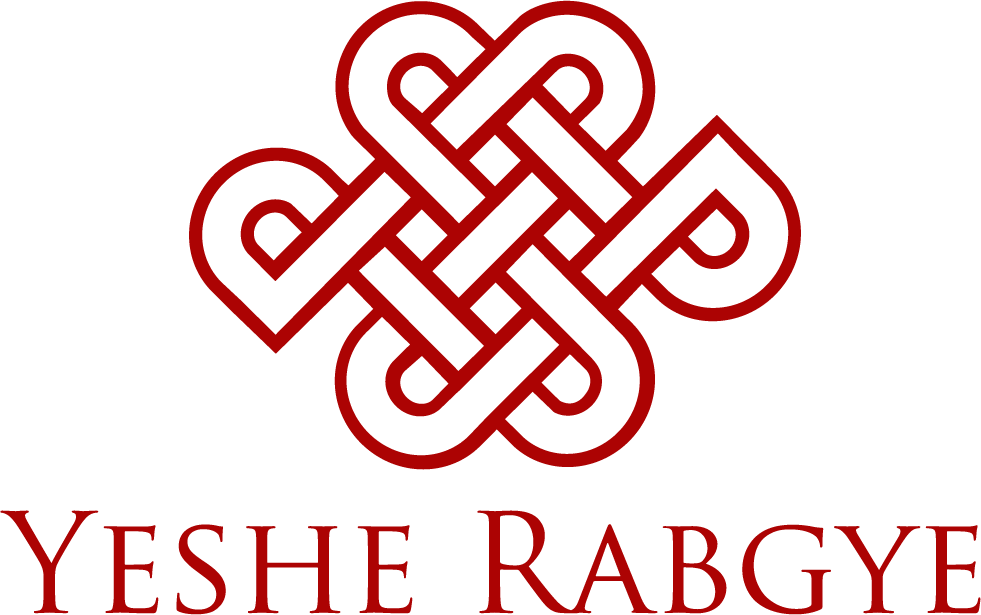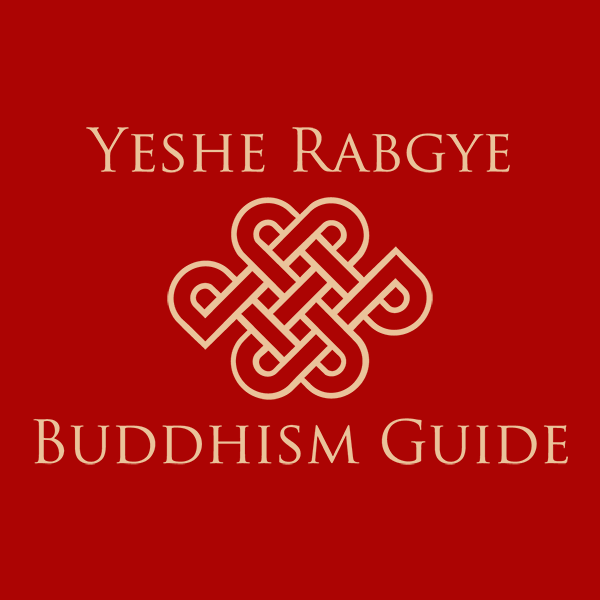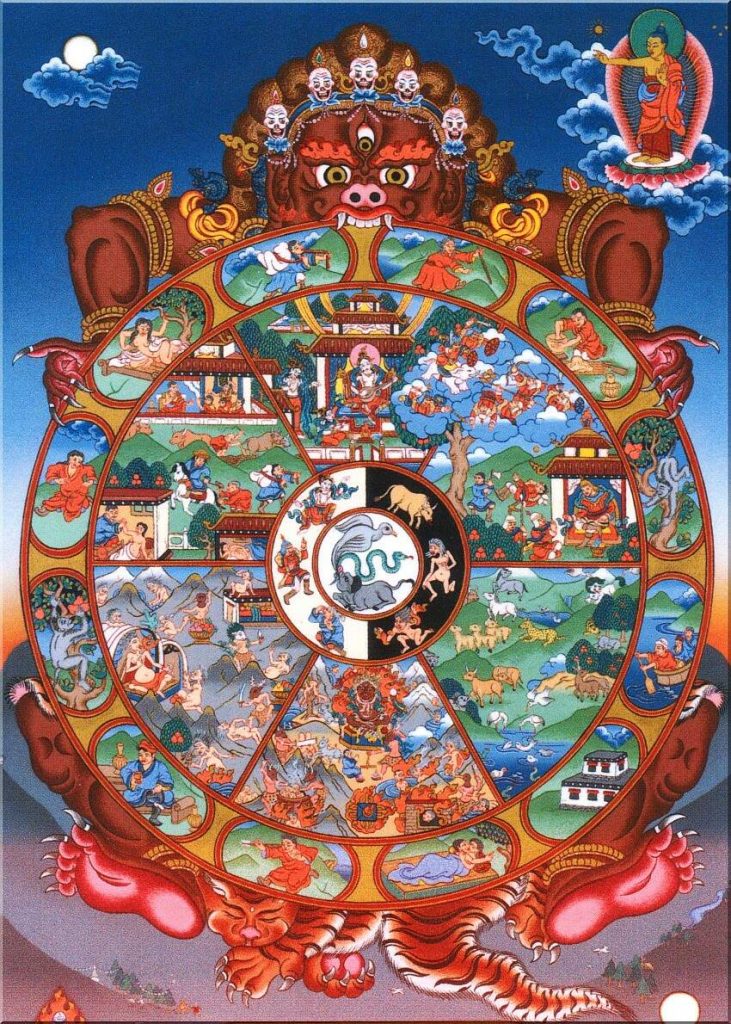The Twelve Links of Dependent Arising
A central teaching in traditional Buddhism is the principle of dependent arising, which states that all things happen through cause and conditions and that they are interdependent. No phenomenon, whether outer or inner, occurs except as a reaction to a previous cause, and all phenomenon will, in turn, condition the following results. So, in a nutshell, because of one thing something else arises. Nothing in this world arises from its own power. Everything comes through causes and conditions.
By looking at things in this way it avoids the two extremes of eternalism and nihilism. Here, eternalism is the view that there is an external god that shapes our fate. Nihilism is the view that there is no relation between action and result, therefore our fate is predetermined.
The Buddhist view asserts that while there is no godlike figure that controls our fate, there are causes and conditions that effect our lives. We are able to change our lives because these causes and conditions can be known and changed.
There are twelve links that constitute the cycle of existence that makes up samsara. This is the endless circle of dissatisfaction that constitutes an unawakened life. We can escape this cycle of birth, old age, sickness, and death by breaking these links.
The links are not regarded as a linear path, but a cyclical one in which all links are connected to all other links.
Being able to escape from samsara can be initiated at any link in the chain, once any link is broken, the chain is forever broken.
In Tibetan Buddhism, the twelve links are depicted in the wheel of life (called the Dharmachakra) which represents the cycle of birth, rebirth, and existence in samsara.
Link One – Unawareness
Being unaware is the basis of all the other links. It is a lack of awareness of how things really are. Our belief in a true ‘self’ and thinking phenomena are permanent leads us to project things which do not exist. We become deluded and confused. It is also about not understanding and implementing the four noble truths. The first truth states that life brings about suffering. When we misunderstand this truth, we fail to realise the true nature of our lives. We believe we are seeing the world as it is, but in reality, we are mistaken. This is where our first sense of a self is starting to form. In the wheel of life this link is depicted by a blind person.
Link Two – Action
When we misunderstand the way life is it causes our minds to become poisoned by greed, anger, and delusion, known as the three poisons. These cause us to act in certain unskilful and negative ways. It is not just because of the three poisons we perform unhelpful acts. There are numerous causes, but these are three of the main ones. We need to remember here that any act we carry out through our body, speech or mind will have consequences. This is depicted by a potter making a pot.
Link Three – Experience
Because of our unawareness, the first link, we perform an action, which is the second link, and this plants a seed in our mind. This seed is just a potential at this point and may or may not come to fruition. That will depend on if we do the same action again. In the future, because of the seed we planted, we will have an experience. This is depicted by a monkey because that is how our minds operate. We jump from one thing to another, just like the monkey jumps from tree to tree.
Link Four – Name and Form
Name and form mean the five aggregates. Name refers to the last four aggregates – feelings, perception, actions, and consciousness. Form refers to the first aggregate. The way we experience the world is through the five aggregates. Firstly, there is a form, this can be an object, sound, taste, etc. and this is picked up by your consciousness. At this point the form has not been labelled, it is just an awareness. It gets labelled by your perceptions and conceptions. Once it is labelled it causes a feeling to arise. This feeling can be pleasant, neutral, or unpleasant. We then act on that feeling. You can read more about the aggregates by clicking on this link. This link is depicted by five people in a boat. The people represent the aggregates.
Link Five – Six Perceptual Entrances
All types of form – objects, sound, smell, taste, touch, mind – are pick up by our six sense faculties – eye, ear, nose, taste, touch, and mind (in Buddhism, the mind is also classed as a sense organ). These are all developed in the womb and will soon become our only means of perception of this world. Hence, they are called the six perceptual entrances. This link is depicted by a house with six windows.
Link Six – Contact
Link four is concerned with subject and link five is the object. This link is the contact between these two. It is the contact between the sense organs and the form, through the consciousness. Three things are happening here: the form, the faculties, and the linking consciousness. For example, an object, the eye faculty, and eye consciousness. There is a form, which is picked up by the faculty (eye, ear, nose, etc) and then linked to the corresponding consciousness, such as eye consciousness and so on. This is happening simultaneously. This link is depicted by a man and a woman embracing.
Link Seven – Feeling
When the sense organs encounter a form, they bring up feelings. These feelings can be pleasant, neutral, or unpleasant. One of these feelings will be present in every experience we have. This is depicted by a man with an arrow in his eye.
Link Eight – Desire
Contact, link six, leads to feelings, link seven, which in turn leads to link eight, desire. So, first, we make contact with a form. This leads to feelings, and these lead us to have desires. These can be desiring for good feelings to last, which they obviously won’t, or bad ones to end, which, because of impermanence, they will. This is depicted by a drunken man.
Link Nine – Grasping
In the last link, we craved and desired for things. In this link, we hold onto them. We get attached and grasp at the things we like and want. This attachment to things brings us untold mental suffering. It must be noted that at this stage the process is still only mental. A man picking fruit is how this is depicted in the wheel of life.
Link Ten – Becoming
This is where patterns of behaviour are formed. Up to now the things we have craved for were just on a mental level. At this point, the actions now become physical and verbal, and so it is known as ‘becoming.’ This is depicted by a pregnant lady.
Link Eleven – Birth
Because of the imprints from your patterns of behaviour created in the last link, you have a certain rebirth. This is depicted by someone giving birth.
Link Twelve – Decay and Death
Once we are born it is inevitable that we will age, get sick and finally die. This link contains all the physical and mental suffering of the human existence. It is depicted by a dying man.
Let’s try to break this down. Because of our unawareness or ignorance of how the world really works, we act in negative and unhelpful ways. This leads us to have experiences. These experiences can be broken down into the five aggregates, form, feelings, perception, actions, and consciousness. Form is picked up by our six sense organs, eye, ear, nose, taste, touch, and mind. This contact leads us to have feelings and desires, which lead us to start grasping and becoming attached. This in turn leads us to act, and the imprints of these actions are what cause us to take rebirth. Because we are reborn, we start the cycle of old age, sickness, and death all over again.
By understanding the 12 links, we can begin to appreciate that things do not happen on their own. There are always going to be causes and conditions. One thing is inevitably going to lead to another.
One of the best ways to break this cycle of an unsatisfactory life is to truly understand the way the world is. Not how we want it to be or wish it was, but how it actually is. To do this we really need to imbibe Buddha’s key teachings. These are:
- Understand and implement the four noble truths
- Understand impermanence, and not just at an intellectual level
- Understand the dangers of attachment and believing in a permanent and autonomous self
- Understand that things happen through causes and conditions
If we can understand and implement these teachings, we will be able to break the first link in the chain, which in turn will break the whole chain forever.
You can read more blogs, listen to podcasts, watch videos and practice guided meditations on my website.
If you would like to become a supporter of Buddhism Guides work, such as podcasts, blogs, videos and guided meditation practices, please visit here. You can support for as little as $2 a month.


